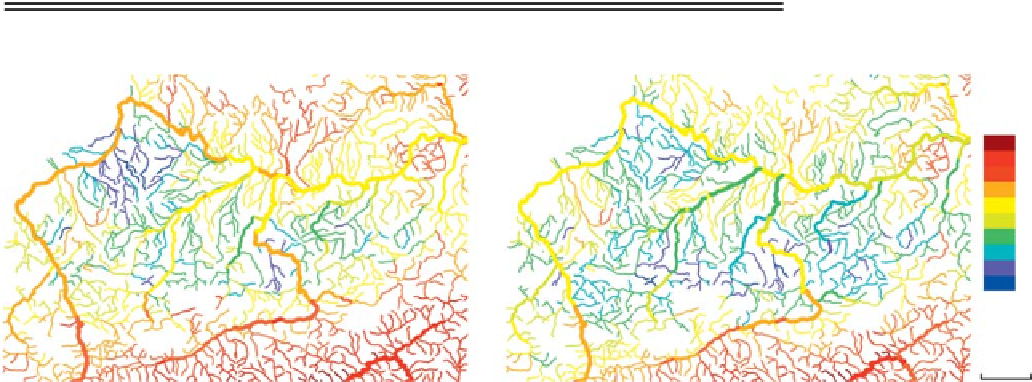Geography Reference
In-Depth Information
Table 10.1. Information that can be used to assist in model structure selection in view of
process fidelity
A-priori perception
of processes
Field data, reading
the landscape
Model structure from similar
gauged catchments
Physics-based models
x
x
Index-based models
x
(x)
Conceptual models
x
(x)
x
26 Mar. 2006
27 Mar. 2006
(mm/d)
0
2
5
10
20
30
25 km
Figure 10.15. Runoff predicted by top-kriging in northern Austria for all locations on the stream network. Note that top-kriging captures the
routing of high runoff depths (
>
15 mm/day) in small catchments on 26 March down the stream network on 27 March 2006.
variety of models, ranging from physics-based models
based on laboratory-scale equations to index-based models
and lumped conceptual models, and everything in between
(Singh and Frevert,
2005
). Although there is a continuous
spectrum of model complexity, in this section we classify
the models into three groups for clarity: (i) physics-based
models, (ii) index-based models and (iii) conceptual
models. For these model types, the similarity concepts
discussed above are used in different ways to select the
model
aims at model structures that reflect the catchment char-
acteristics such as topography, soils, geology, vegetation
and the physics of water flow processes in a realistic
way. The level of detail with which this is done, how-
ever, varies widely. Three groups of information can be
used to guide model selection in view of process fidelity
(
Table 10.1
).
A-priori perception of processes: Very often, modellers
have at least some basic prior knowledge of the flow
processes in the catchment for a given hydroclimate and
landscape setting. These may provide an idea about
what the dominant processes could be, to guide what
should be the essential model components and what
simplifications may be possible. For example, in regions
where stream
structure and parameters
in ungauged basins
(Blöschl,
2005
).
10.4.1 Structure of rainfall
-
runoff models for
ungauged basins
The starting point for predicting the runoff hydrograph in
ungauged basins using rainfall
aquifer interactions are important for run-
off (e.g., Denmark), an obvious model choice based on
this prior perception is coupled groundwater
-
-
surface
runoff models is the
choice of a suitable model structure. The model structure
represents a formalised perception of how the catchment
system is organised and how the various parts are inter-
connected. Selection of the type of model for predictions
in ungauged basins usually depends on a number of
factors. Most importantly, one usually strives to repre-
sent the runoff processes in a realistic way, so that the
model can be safely used in a predictive mode, i.e. one
-
water models.
Field data, reading the landscape: The model
choice can be assisted through field data collected in
the catchment and a process of rapid assessment, includ-
ing field visits, data analysis and even preliminary mod-
elling. Such a rapid assessment might inform what
model structures are feasible (with respect to money
and time) at the scale of interest, as a trade-off between



Search WWH ::

Custom Search